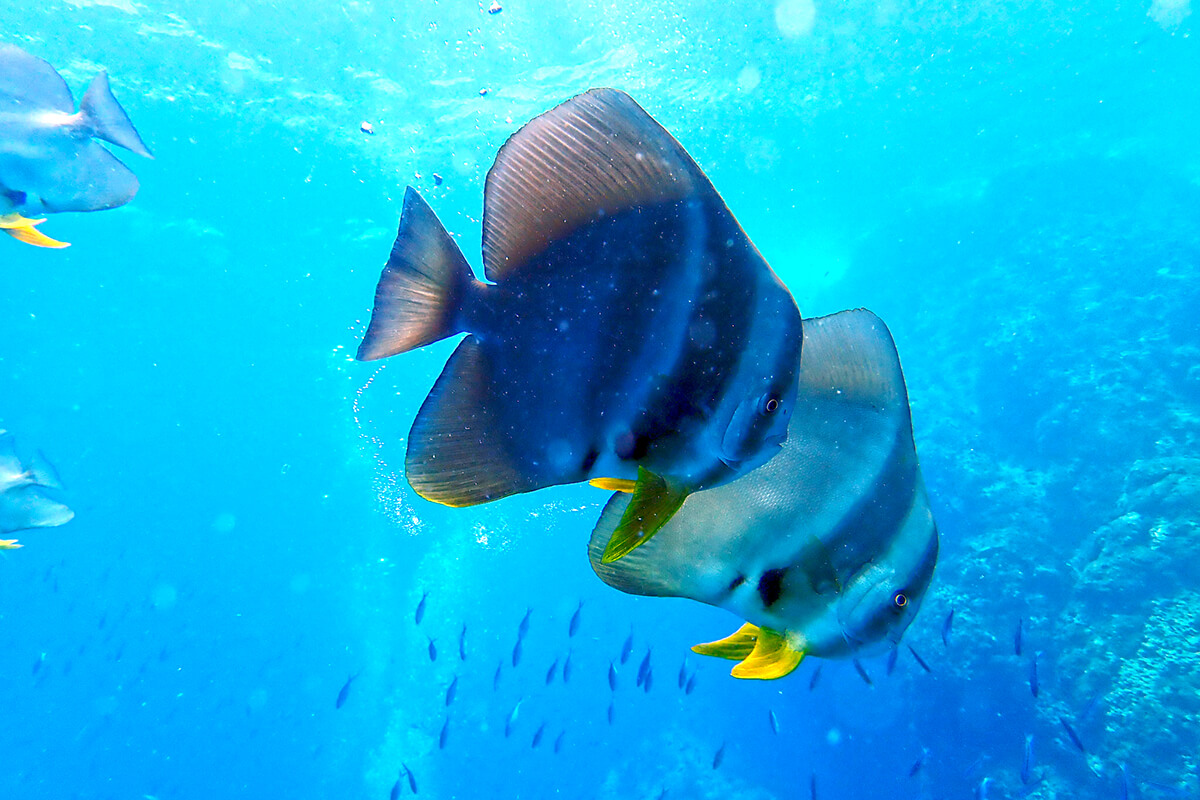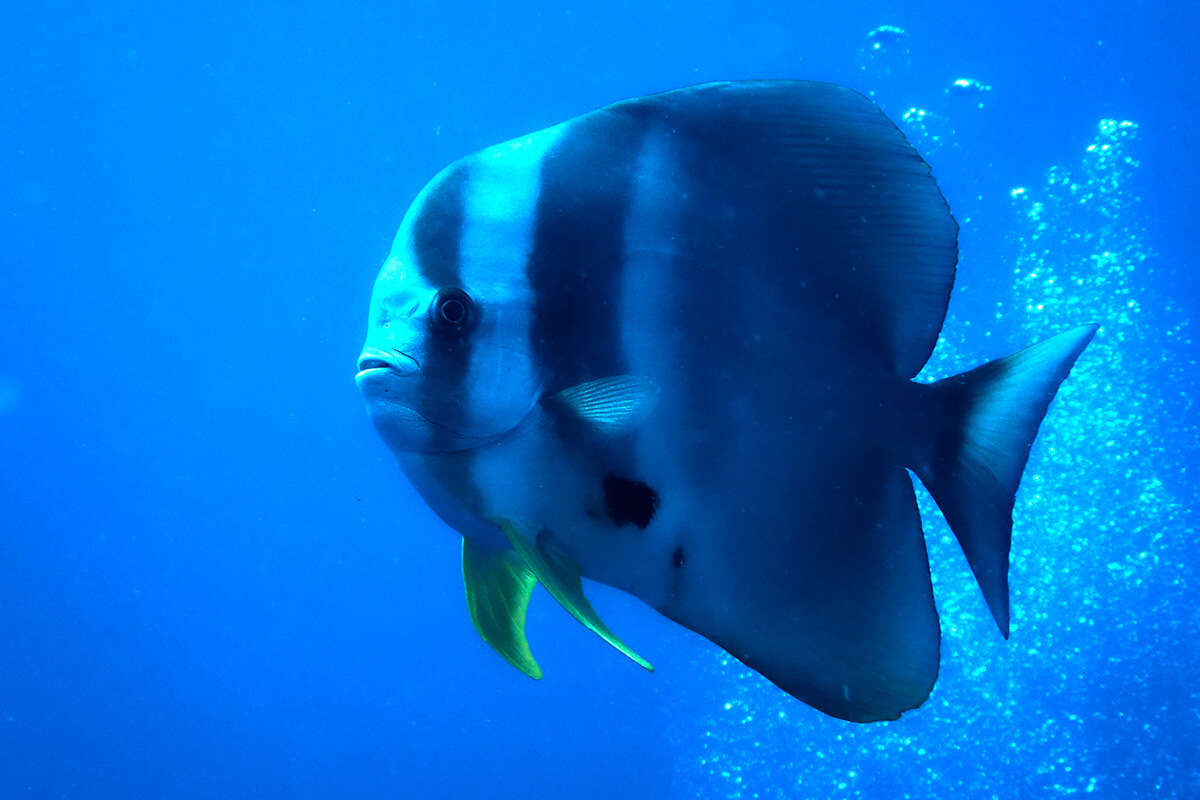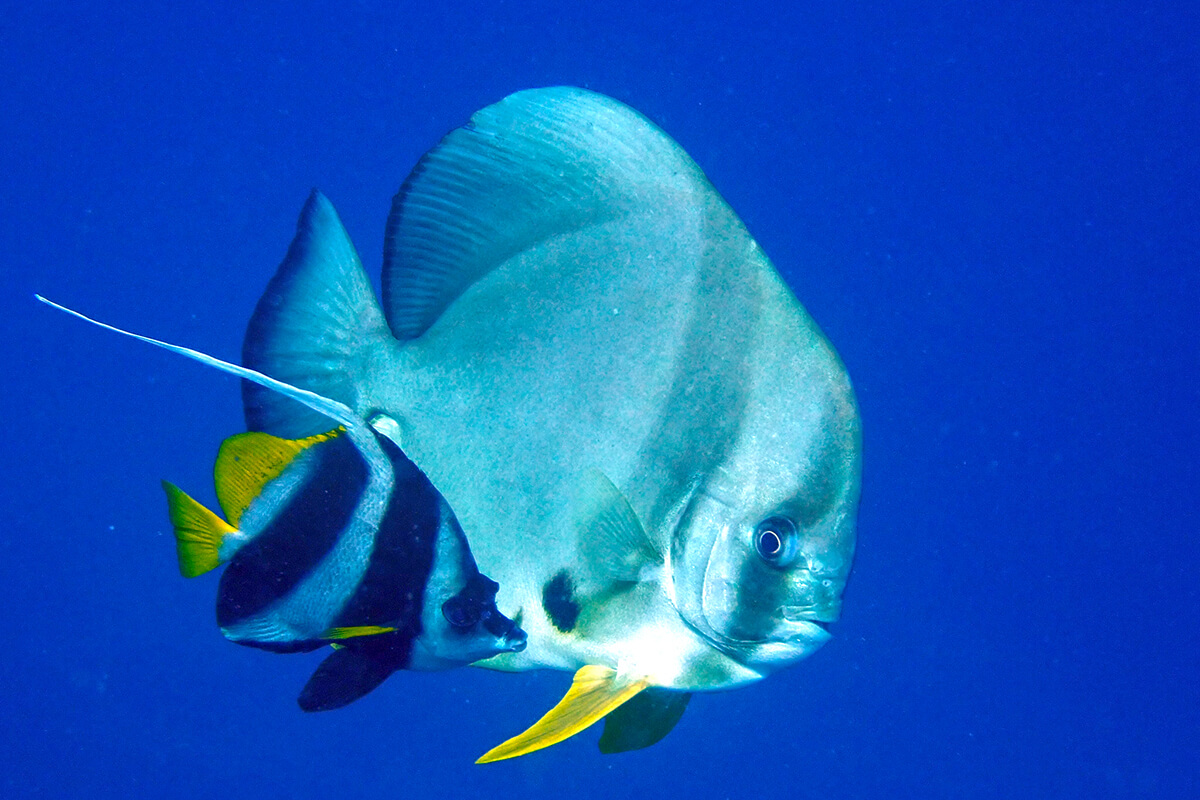Like a big linen cloth, they sometimes hang and float in the water – the batfish at Sail Rock.
Their flat body, a small mouth with small, bristle-like teeth and small scales. The dark-coloured vertical bands over the eyes and lateral fins, described as characteristic.
Platax is a genus of Indo-Pacific, reef-associated fish belonging to the family Ephippidae. There are currently five known extant species generally accepted to belong to the genus. They are one of the fish taxa commonly known as “batfish“.
The batfish’s diet consists mainly of worms, crabs and jellyfish.
Batfish are very curious. They have often been observed swimming after divers and nibbling on their equipment or fingers. They also like to try to snatch the air bubbles that divers raise. Little is known about the reproduction of the animals.
Species of batfishes:
- Platax batavianus (Humpback batfish)
- Platax boersii (Golden spadefish)
- Platax orbicularis (Orbicular batfish)
- Platax pinnatus (Dusky batfish)
- Platax teira (Longfin batfish)
Orbicular batfish
The orbicular batfish (Platax orbicularis), also known as the circular batfish, orbiculate batfish, round batfish, or orbic batfish is a popular aquarium fish which occurs naturally in the tropical waters of the Indian and Pacific Oceans. These fishes are sought after for their high prize by nearby pacific communities as they are known for their high-quality meat.
In the wild, the orbicular batfish is found in brackish or marine waters, usually around reefs, at depths from 5 to 30 meters. Its range extends from the Red Sea and East Africa in the east to the Tuamotu Islands in French Polynesia in the west, and from southern Japan in the north to northern Australia and New Caledonia. It has been recorded off the coast of Florida, though this may be the result of dumping of aquarium specimens.
The body of Platax orbicularis is almost disc-shaped, and very thin. Its tail, about 20% of the body length, is fan-shaped and is taller than it is long. Males can grow to up to 50 cm (20 in) in length, though aquarium specimens are generally much shorter.
Juvenile fish are solitary or live in small groups, among mangroves or other inner sheltered lagoons. Adults are found in more open waters and at greater depth.
Platax teira (longfin batfish)
Platax teira, also known as the teira batfish, longfin batfish, longfin spadefish, or round faced batfish is a fish from the Indo-West Pacific. It occasionally makes its way into the aquarium trade. It grows to a size of 60 cm (24 in) in length.
Platax teira has a dark blotch under the pectoral fin, with another long dark mark above the base of the anal fin. Looked at from the side, it has a roughly circular body with a low hump on the nape. This fish is usually silver, grey or brownish. It has a blackish band through the eye and another band with the pectoral fin. They will change colour from silvery white with no bands, to brown with darker banding as you watch, and then fade back to silver again.
In Australia it can be found from the central coast of Western Australia, around the tropical north of the country and south to the southern coast of New South Wales. In India it was reported from the Gulf of Mannar. It has also been discovered as an invasive species off the Mediterranean coasts of Turkey (in 2006) and Israel (in 2010).
The species occurs in shallow coastal habitats to deeper offshore.
They are known to reside among floating seaweed, debris, and artificial reefs.
Platax teira is an omnivore. It will eat plankton, sessile invertebrates, small invertebrates, and marine algae.
Platax pinnatus (red-faced batfish)
Platax pinnatus, also known as the pinnate spadefish, pinnate batfish, pinnatus batfish, dusky batfish, shaded batfish, or red-faced batfish is a fish from the western Pacific that occasionally is kept in marine aquariums.
As a juvenile it is blackish brown, or black with an orange stripe outlining its entire body. Adults become a dull silver. This fish grows to a maximum size of 45 cm (18 in).
Adult fish get a more discus-like shape, the fins are no longer so high in relation to the body, the body becomes silver-grey. Like the other batfishes, they get three slightly dark grey vertical bands. They can be distinguished from their relatives by their more pointed snout. They usually live in pairs further seaward, in deeper lagoons, reef channels and outer reefs.
The attractive-looking juveniles are sometimes offered by irresponsible dealers as marine ornamental fish. However, due to the expected final size, they are completely unsuitable as a stock for the private reef aquarium and are also difficult to feed.
Where do we see batfish during our diving trips?
We mainly encounter batfish at Sail Rock or Shark Island (in the south-east of Koh Tao). So come along to Sail Rock and sign up here.





